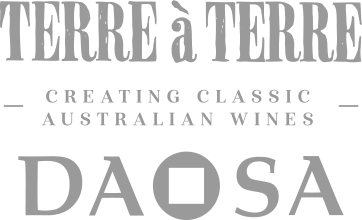Vintage 2015 – Terre à Terre vineyard
Our unique closed-spaced Terre à Terre vineyard in Wrattonbully has produced what is probably our best fruit thus far.
Climate
The 2015 growing season started early, with dry and mild weather favouring slow but very good flowering and fruit set in all varieties. Véraison occurred early and quickly for the Sauvignon Blanc, and for the red varieties véraison was slow after an early start. The Terre à Terre vineyard did not experience any severe heatwaves in 2015, apart from a couple of days reaching close to a maximum of 40 degrees in January and in February. Both months were quite warm on average. This favoured perfect ripening conditions for our Sauvignon Blanc, which will be fuller bodied this year. On the other hand, the red varieties enjoyed very mild weather from véraison to harvest (all our red varieties had 8 to 9 weeks from véraison to harvest).
The weather station in the Whalebone vineyard, next to the Terre à Terre vineyard, shows 1,522 degree days from October 2014 to April 2015, which is slightly higher than average and close to the Bordeaux average of 1,486 degree days. We believe that because of the low trellis of our vineyard (50cm above ground, compared to 1.8m height for the weather station), the vineyard heat degree days would probably be closer to 1,450 degree days. 2015 was a fantastic growing season for our Sauvignon Blanc, harvested early with good acidities, sugars and intense flavours, but also for the red varieties, which ripened very slowly and are already showing great complexity in barrel.
Harvest
Sauvignon Blanc
We handpicked our Sauvignon Blanc on the 18th and 19th of February 2015 and on the 24th of February 2015. The berries had an amazing flavour profile – something we now consider normal for this vineyard. We produced a Terre à Terre cuvée – for the first time, the fruit was whole bunch pressed, and fermented in oak barrels, demi-muids and one large oak foudre in a temperature controlled cellar – and a Down to Earth cuvée – crushed and destemmed fruit, fermented in stainless steel at even lower temperatures and in a 3,000L oak foudre. These two cuvées have now finished fermentation and are sitting on yeast lees with occasional bâtonnage. The alcohol is around 13.5%v/v, and the cuvees already display amazing flavours and acidity.
Shiraz
We handpicked our Shiraz on the 17th of March 2015. We got yields of 9.03 tonnes per hectare, after bunch thinning at véraison down to 10 bunches per vine. The Shiraz was fermented in 1 8-tonne Potter fermenter and 1 small 1-tonne tub (which had 50% whole bunches), with plunging 4 times during fermentation. After 26 days of cold maceration, fermentation and post fermentation maceration, it has now been pressed off skins and transferred to new Vallaurine barrels (Rive Droite and Rive Gauche) and old French barrels ready for malolactic fermentation. It will yet again be a classic example of “old world” Shiraz – from Australia. The tannins are very ripe and the wine had pronounced blueberry flavours at the press.
Cabernet Franc
The Cabernet Franc came off at the same time as the Cabernet Sauvignon, on the 25th of March 2015. The yields were excellent at 6.91 tonnes per hectare. The Cabernet Franc was all fermented in small 1-tonne tubs, with plunging once a day. Half of the tubs had 50% whole bunch fruit and fermented on wild yeasts, and the other half was all destemmed with partially crushed fruit and was seeded with our own yeast culture. The whole fruit and the crushed fruit were pressed off skins as separate batches and racked to separate barrels. It will be very interesting to see how both wines evolve in the next few months – they are already displaying classic Cabernet Franc characters with great tannin structure and floral aromatics.
Cabernet Sauvignon
On the 29th and 30th of March 2015 we handpicked our close-spaced Cabernet Sauvignon. With textbook yields of 8.12 tonnes per hectare, the fruit was perfectly ripe at harvest, with amazing Cabernet Sauvignon fruit flavours and solid Baumé readings of 14.8. The must was fermented in 1 8-tonne Potter fermenter (cycled only once during vintage) and 3 small 1-tonne fermenters with plunging once a week. Fermentation was very slow (less than 1 Bé per day) and the wine was pressed off skins after 30 days of maceration and fermentation and left to settle in a tank for 12 days before being racked to new and old Dargaud and Jaegle barrels. It is early days yet, but it looks like this will be one of the best Cabernet Sauvignon so far for Terre à Terre!



